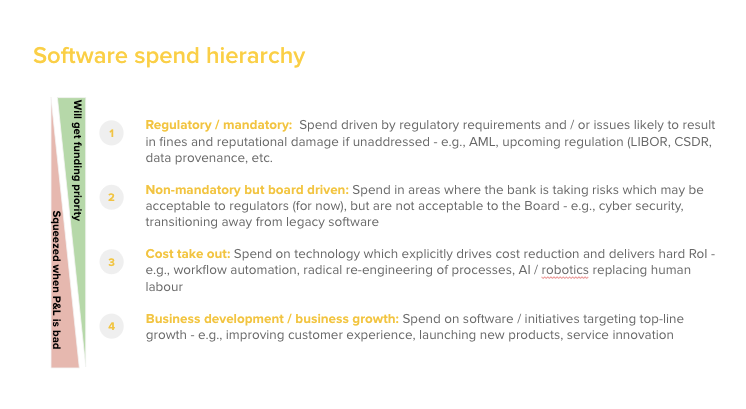Amid regulatory, cost, and competitive pressures, big banks are focusing on fixing critical infrastructure. Innovation in flashy new products might have to wait
The banking sector shelled out $444bn on IT and software spending in 2020, by far the biggest single spend by an industry vertical, according to Gartner. Yet selling software to them can be a daunting exercise — organisations are complex, priorities change, and decision-making can take months.
Last month, I spoke with a group of senior software buyers across most major banks to work out where software dollars are likely to go and which startups are well-positioned to tap into this spend.
What banks are spending on now is an excellent litmus of where they are — or aren’t — heading. When the requests for IT spend come in during budgeting season, there is a clear hierarchy of needs which drives where the list gets cut. The overall hierarchy looks something like this:

Regulatory, risk management, and cost take-out initiatives (and therefore spend) take up the majority of the tech budget. It is not until we get to the fourth priority that improving the customer experience or innovation to drive the top line comes into it.
Talk to anyone senior, and of course they’d love to have a great customer experience, UX and an innovative product. But in an environment dominated by high cost-to-income ratios, brittle infrastructure, and an ever-more complex regulatory environment, these are a wishlist, not requirements.
Meanwhile, startups competing with banks demonstrate inverse spending: they have none of the above requirements and strictures (although regulators are quickly catching up with them); their number one concern is the customer experience. They are starting with the fourth priority. And for businesses building for banks, these spending priorities also give a clear indication of where your focus should be.
If your product is addressing priorities 1, 2 or 3 (with very clear RoI), it will be much easier to get prioritised. If, instead, your focus is on enabling product innovation, better customer UX, etc, expect a harder time to secure budget allocations and greater risk of delays. Despite the macro drivers of bank spend remaining the same, the shape of this prioritisation, and what sits in each bucket, has changed over time.
For example, a huge focus for banks over the past five to ten years has been to digitise their front-end and front-office functionality and move clients to cheaper self-service channels (think improving your mobile banking app, or the client portals and reporting for corporates). This work has, by and large, been completed (with varying degrees of success), and focus has now shifted to looking at ways to automate and digitise middle and back-office processes. Buyers are likely to look at automation, robotics, and AI solutions that help significantly reduce costs or, indeed, help reimagine whole processes and improve efficiency.
Another clear direction of travel over the past decade has been the dismantling of legacy infrastructure. Banks are at different stages in this transition, with Capital One recently announcing that it will be fully cloud-enabled as of next year, while other more complex institutions are still far behind.
However, the trend holds: away with monolithic infrastructure and in with a best-of-breed microservices approach, including open-source software. A startup that positions itself as a best-of-breed component within a bank’s microservices architecture is much more likely to gain attention than a player that comes with a “holistic platform” approach. To put it in the words of one software buyer I spoke to: “My processes are so complex and my regulatory scrutiny so high that you will never be platform enough for me.”
Finally, the regulatory/mandatory bucket is, of course, perennially driven by the next big piece of regulation to be implemented. The most palpable shift in focus here has been from financial to other risks. Regulators are particularly looking at the risks created by the complex legacy tech stack and the risks of bad or rogue data causing real-life damage. Citi Group was recently fined $400m by a US federal regulator for precisely this reason.
The infrastructure weaknesses described in the regulator’s report apply to pretty much every other major bank out there. Expect many millions, if not billions, of bank software dollars to be spent on data quality, lineage, and permissioning and controls in the next few years.
Infrastructure for banks isn’t going to be reinvented overnight. Build components with purpose, rather than holistic platforms — these are much more likely to be bought by banks to solve real issues than businesses trying to build an all-in-one solution to meet complex demands with which they are unlikely to contend.
While there are many opportunities to capture software dollars from banks, one thing remains true: for most, the focus of the next few years remains on digging themselves out of the trenches of legacy software and processes. Reordering those spending priorities, and placing customer experience at the top is the only way they can continue to compete. It’s the only way to halt decline.


